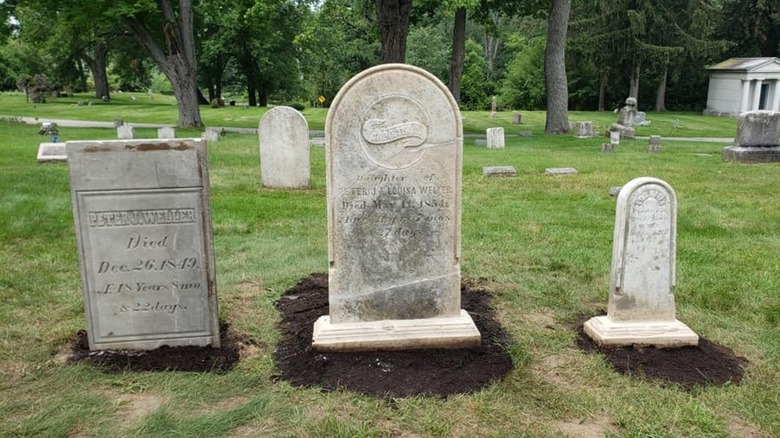This Mystery Tombstone Was Used As A Fudge-Making Station
In fudge-making, the forming and cooling of this rich treat often takes place on a marble slab. This is because marble is great at absorbing the heat of the warm fudge and preventing the formation of sugar clumps that can rob fudge of its smooth texture (per Marble Candy Slabs). You needn't purchase a new, pricey piece of marble for fudge-making, though. Any marble slab will do, like, say, a big old tombstone.
As ghoulish as it sounds, that's exactly what a family in Okemos, Michigan, was up to for who-knows-how-long. According to MLive and Food & Wine, the family was using the 5-foot-tall gravestone (pictured above on the left) of the late Lansing, Michigan, businessman Peter J. Weller, who died in 1849, as a fudge-making station. How they got ahold of the tombstone isn't known. We do know that after his death, the 48-year-old Weller was laid to rest in Lansing's Oak Park Cemetery. His remains were moved to a family plot at Mount Hope Cemetery about 26 years later, but apparently, somewhere along the trip, his headstone disappeared.
The movements of the tombstone over the last 146 years are still mostly a mystery, but its discovery came when Epic Auctions & Estate Sales was hired to evaluate the contents of a fudge-loving family's house earlier this year after the homeowner was moved into an Alzheimer's facility. Epic Auctions' Brad Stoecker said he was "puzzled" to discover what turned out to be somebody's headstone in the home.
The 'fudge slab' was returned
The unnamed family claims to have no idea how a large tombstone came to be in their possession, according to Loretta Stanaway, president of Friends of Lansing's Historic Cemeteries (FOLHC). Stanaway told MLive, "The homeowners just said, 'We used the backside of it to make fudge.' Although it might seem implausible that they never noticed the engraving on the back of their fudge slab, Stanaway said there's no way to know if they "knew it was a legitimate monument or if they thought it was just a throwaway."
Another head-scratching aspect to the story is that, (per a Facebook post from FOLHC), Epic Auctions & Estate Sales intended to sell the headstone along with the other knick-knacks from the home where it was found instead of investigating its provenance and ownership. Fortuitously, a California man and one-time Lansing resident spotted it on the auction site and figured it should be investigated. At his prompting, Epic Auctions turned the tombstone over to the city (via Food & Wine).
Because none of Weller's relatives could be located, the city granted FOLHC permission to hire a cemetery preservationist to place the stone where it belonged: at the grave of Peter J. Weller. A dedication ceremony, nearly 150 years after Weller's death and the monument's disappearance, will be held on September 26 at the cemetery. We're glad Peter's grave will receive this measure of dignity and closure. But for some reason, we're also craving fudge.

